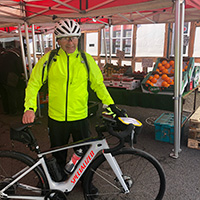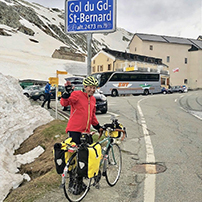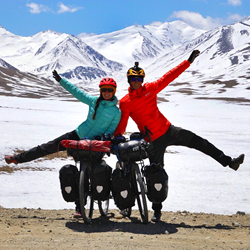Taking bicycles on planes
 It is perfectly feasible to take your bikes on most airlines, the rules and regulations do vary from carrier to carrier. Most airlines require you now to bag or box your bike, very few just allow you to remove the pedals, deflate tyres and turn the handle bars around. You will need to check with the airline that you intend to use well before booking as if you turn up with an un-bagged bike the airline may refuse to handle it!. Most of the airlines include the weight of you bike in you luggage allowance, so be warned you could incur excess baggage charges!!
It is perfectly feasible to take your bikes on most airlines, the rules and regulations do vary from carrier to carrier. Most airlines require you now to bag or box your bike, very few just allow you to remove the pedals, deflate tyres and turn the handle bars around. You will need to check with the airline that you intend to use well before booking as if you turn up with an un-bagged bike the airline may refuse to handle it!. Most of the airlines include the weight of you bike in you luggage allowance, so be warned you could incur excess baggage charges!!
Our first experience of taking our bikes on planes was on our 2000 tour of Finland when we flew with Buzz from Stansted to Helsinki. Their regulations then were that the bikes should have both wheels and pedals removed, tyres deflated and handle bars turned around. We decided that as they required both wheels removed we would pack the bikes in bike bags.
We purchased two bike bags from St Johns cycles in Bridgewater as they seemed the biggest in size to cope with our large touring bikes and the best value. We then had the problem of how to get to the airport, we decided on the outward to go by train as Stansted has it's own terminus.
This meant that we could pack the bike bags at home saving the hassle of having to take them to pieces in the airport concourse (this was the right decision as Stansted was heaving with people that day) We found the bags reasonably easy to carry although it helps to be tall! On our return journey we were picked up at the airport by mother in law with our car and the bike rack. This did involve rebuilding the bikes in the car park but then there was not the pressure of meeting flight departure times.
Although our bikes did suffer some minor damage on the outward journey (a broken bottle cage and a crack in the plastic chain guard), we think this was mainly due to them being opened by customs in order to have their wheels sprayed against 'Foot & Mouth' and then not being repacked properly.
Our second flight with the bikes was with Norwegian Airlines to Norway in 2006, again we used the bike bags and had no real problems, although the bike bags did suffered a bit of scuffing and rips but the bikes were undamaged.
Frank adding the last bits of tape to secure the bike bags.
Our next flight with the bikes was in 2008 on our trip to Iceland. We decided that as the bike bags had got scuffed a lot and ripped a bit the previous year that may be we had had been lucky. It also took a lot of time taking the bikes to pieces and then having to reassemble them, it also meant that we couldn't easily ride straight out of the airport. We decided to try using the big 'see through' CTC plastic bags available from Wiggle. We were working on the principle that if the baggage handlers could see it was a bike it may get better treatment. It also meant that we didn't have to completely dismantle the bikes as we previously had to with the bike bags and we wouldn't have to worry about having to find a place to leave the bike bags.
We simply removed the pedals, lowered the seats, lowered and rotated the handle bars before deflating the tyres a bit and then slid them into the plastic bags and taped them up. We did try cutting slits for the bottom of the wheels to poke through so you could roll them but this didn't really work very well. That year we had no damage both on the outward and return flights between Stansted and Keflavík. The baggage handlers at both airports obviously did a good job.
|
Video of our bikes being loaded at Keflavík airport |
Our bikes on the trolleys at Keflavík airport. |
On our flights out to Iceland in 2009 we used the CTC bags again and had no problems on the outward journey, however after our return flight Frank noticed that her gears were not changing correctly. On taking her bike to our LBS they told us that the dérailleur arm was out of true, we suspect that it may have taken a knock on the flight. It is obviously the one vulnerable part of the bike and thus when we packed our bikes for our flight to Krakow in 2010 we removed the dérailleur arm and wrapped it in a plastic bag and taped it to the chain-stay.
Friedel and Andrew of the 'Travelling two' site have had the same success with using the CTC plastic bags and have found a novel and neat place to store the CTC bags whilst on tour.
On our Poland tour in 2010 due to having to come back early as Frank had hurt her back and we had sent our CTC bike bags on to Prague. We had to fly the bikes back in cardboard boxes, we I had to search all over Kraków to find some big enough to take our large touring bikes. Even putting bits of ply in the bottom to protect the front chain ring and cutting up a cheap sleep-mat that I bought from the camp-shop to pad out the box the box arrived with some damage. One of the bike's quick release skewers was poking out of the cardboard and the front racks were a bit bent. Fortunately there was no damage to the main frame, forks or wheels and I managed to straighten the racks out using a vice and a Rawhide hammer.
All in all we were quite lucky when we flew our bikes back from Kraków in cardboard boxes as we had minimal damage.
 |
 |
Considering the potential damage that could be caused to a bike even if it is boxed in a cardboard box we are thinking of splashing out on a proper rigid bike box.
To use bike bags or not to use bike bags?
These are our thoughts about whether to use cardboard boxes, plastic bags, soft bike bags or hard cases, perhaps you have other experiences in which case we would interested to know.
| Container Type | Advantages | Disadvantages |
|---|---|---|
Cardboard cycle box |
|
|
CTC plastic bag |
|
|
Soft Bike Bag |
|
|
Hard Bike case |
|
|
What do you do with bike boxes & bags when you are touring?
In answer to one of the disadvantages of bike bags or cases 'What do you do with them when you are touring', (they are too bulky to contemplate carrying them). When we flew to Helsinki we stayed our first and last nights at an airport hotel which we had booked in advance. When I booked I managed to negotiate that we could leave our bike bags left at the hotel until our return, this they kindly agreed to at no extra charge (they were stored in a locked room usually set aside for luggage).
Which ever way you chose there is one thing that you should do if you do use a bike bag and remove any of the wheels is to reinforce the drop-outs. One of the main strengths of a frame is the fact that the axles hold the forks and rear frame in tension. Without the axles there is a chance that if some thing heavy were dropped on the frame or forks they could be bent. By putting some reinforcement between the front and rear drop-outs you can help prevent too much damage.
How we packed our first bike bags
The bikes dismantled in the bike bag |
In order to get the bikes into our soft bike bags we had to remove the rear carriers, mud guards and the rear stands as well as the wheels and pedals. With the handle bars dropped and turned they only just fitted. To protect the drop-outs I simply bought some 8mm studding, some large washers and nuts from a Hardware store. I then cut the studding to size, adjusted the inside nuts and washers to the size of the drop-outs, then tack welded the washers to the nuts and the nuts to the studding. Fitting is then easy, simply drop them into the drop-outs, place a washer and a nut on the outsides of the drop-outs and tighten with a spanner. |
Reinforcement between the drop-outs to prevent the frame & forks from getting bent. |
The wheels had their own bags which gave a good bit of protection and stopped them from rubbing on the frame. I did remove the axle skewers to prevent them from getting bent. There were several bags attached to the inside of the bag which held the pedals and the saddle. I carefully removed the dérailleur and taped this to the rear stay. I wished I had put something over the dropout protectors as these ended up being forced through the bag side. Perhaps those cane ends you see at garden centres would have done the job. |
Most airlines usually allow only one hold bag and 1 cabin bag, how do you get around this issue with 4 panniers and a Racpac each?
 To get around this problem when flying we have purchased a couple of large nylon tote bags made by Exped which are big enough to fit 3 panniers and 1 Racpac each, we take one front pannier on the plane as hand luggage. They are reasonably light weight but still quite strong and fold away into a small pocket at one end. They are small enough that you could carry them if you had to but we either ask at a campsite or hotel where we might be staying and returning to at the beginning and end of a tour if we can leave them and pickup them up on our return or else we have posted them on to a hotel that we have booked for the night before our flight. If you are flying with a bike and using a box or bag you will probably need to leave them somewhere so the tote bags can stay with them.
To get around this problem when flying we have purchased a couple of large nylon tote bags made by Exped which are big enough to fit 3 panniers and 1 Racpac each, we take one front pannier on the plane as hand luggage. They are reasonably light weight but still quite strong and fold away into a small pocket at one end. They are small enough that you could carry them if you had to but we either ask at a campsite or hotel where we might be staying and returning to at the beginning and end of a tour if we can leave them and pickup them up on our return or else we have posted them on to a hotel that we have booked for the night before our flight. If you are flying with a bike and using a box or bag you will probably need to leave them somewhere so the tote bags can stay with them.
A good site for further information on taking bikes on planes is 'Travel with Bicycles' and there is also some good advice on this page of the CTC site.
Removing pedals
To remove the pedals:
- The left pedal comes off clockwise and goes on anti-clockwise.
- The right pedal comes off anti-clockwise and goes on clockwise.
If you are going by plane remember to add a pedal spanner or Allen Key to you packing list. If you do forget your spanner generally most pedals need a thin section 15mm spanner. We also suggest that you have a practice removal before you leave home, as some bike shops tend to over tighten the pedals. A little bearing grease smeared onto the threads can help with easy removal.





































 The Celtic Cycling Circle
The Celtic Cycling Circle Cycling alongside the Grand Union Canal
Cycling alongside the Grand Union Canal 5 Essential Items to Take with You on Your First Cycling Tour
5 Essential Items to Take with You on Your First Cycling Tour Favorite Cycling Destinations: Sardinia
Favorite Cycling Destinations: Sardinia Pamir to Karakoram- cycling the highways on the roof of the world
Pamir to Karakoram- cycling the highways on the roof of the world 4 Wheels 2 Hearts 1 World - A Day in Our lives
4 Wheels 2 Hearts 1 World - A Day in Our lives Koga E-Worldtraveller - e-bike review
Koga E-Worldtraveller - e-bike review Ten tips for tandem cycle touring
Ten tips for tandem cycle touring colmandsamstreks - Two Beginners in France
colmandsamstreks - Two Beginners in France


